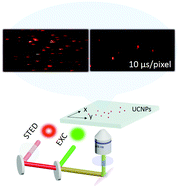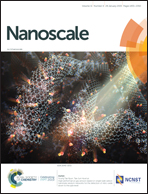Fast upconversion super-resolution microscopy with 10 μs per pixel dwell times†
Abstract
Multi-photon upconversion super-resolution microscopy is a recently proposed imaging modality, based on lanthanide-doped nanocrystals, which can emit visible emission upon low-intensity near-infrared excitation. This imaging modality exhibits many advantages, including increased imaging depth, high signal-to-noise ratio, low phototoxicity, and high photostability. However, two factors seriously restrict its scanning speed, sometimes even to an intolerable degree; the long lanthanide emission lifetime and the low brightness. For proper imaging, pixel dwell times of several milliseconds are often required. In this work, a facile strategy is proposed to overcome these two obstacles. By adopting a high sensitizer (Yb3+) doping strategy for upconversion nanocrystals, their emission intensity is greatly increased and their emission transients are significantly accelerated, without losing the emission depletion efficiency induced by the depletion laser. This enables the implementation of a very fast upconversion stimulated emission depletion super-resolution microscopy with a scanning speed of 10 μs per pixel. This work opens the possibility for upconversion super-resolution microscopy to capture vital biological activities in real time.



 Please wait while we load your content...
Please wait while we load your content...